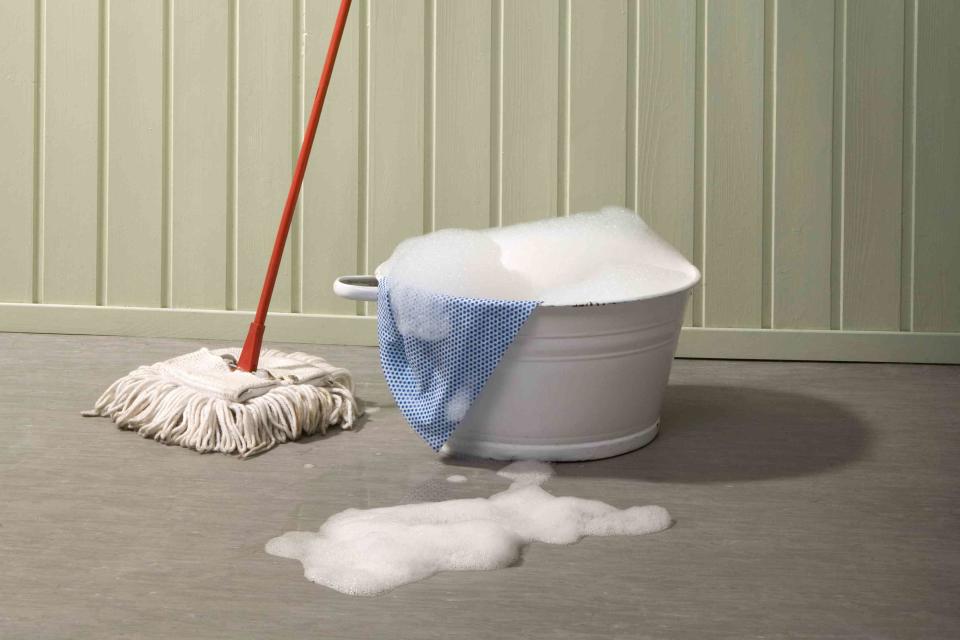This Is How Often Should You Mop Your Floors
Expert pro tips on ideal mopping frequency and getting the sparkling floors of your dreams.

Iris Friedrich/Getty Images
Only a handful of chores inspire you to breathe in deeply and say, “Ahh!” upon completion. Mopping your floors is one of them, largely because this household task quickly nixes tons of gunk from a pretty substantial surface. The result is fresher air and an instantly cleaner-looking space.
Related: 9 Tips This Cleaning Editor Wants Everyone to Know
“Mopping removes dust and debris, bacteria, and other contaminants from the floor’s surface, contributing to a healthier environment with better air quality,” notes cleaning guru Robin Murphy, founder of ChirpChirp. “It’s not only nice that homes look clean, but cleanliness is important for the health and well being of the people living in the home.”
It’s a sizable task, though, so how often should you mop your floors? Keep reading for the answer.
How Often to Mop Your Floors
Generally speaking, it’s best to mop your floors at a cadence of once every two to three weeks. This pacing will help keep your home fresh and clean, and can help elongate the lifespan of your floors. That said, there are some factors that can impact whether you should mop more or less frequently.
Traffic Volume
High traffic areas prone to getting dirty—like the entryway, kitchen, and bathrooms—can benefit from more frequent cleaning. And if you have pets, your home accumulates a lot of dust, or have children who play on the floor, then mopping multiple times a week (or even daily) may be best.
Floor Type
The type of flooring in your home may impact how often you should mop. For example, Murphy says that tile typically requires more frequent mopping compared to wood or laminate. “This is not just because it shows the grime on the tile, but also because dirt and dust often accumulate in the grout lines and dirty grout makes it obvious that the floor is dirty and is hard to get clean,” she explains. Sealed wood floors, on the other hand, can be mopped less since the seal resists stains and moisture.
Light or very dark flooring is also more likely to show dirt more quickly than medium-colored flooring. This may inspire a more frequent mopping schedule to keep things looking clean and tidy.
Lifestyle and Habits
Your lifestyle and habits may also impact how often you need to mop your floors. For instance, if you have a pet or tend to track dirt into the home, then more frequent mopping makes sense. If you travel often or your home doesn’t see a lot of activity, then you can probably get away with mopping less frequently.
Light Versus Detailed Mop
A detailed mopping is a bigger chore that involves moving furniture, going under and behind objects, and sometimes getting on your hands and knees to scrub tough spots.
This is what we’re referring to when we recommend mopping once every two to three weeks. A lighter mopping session, on the other hand, involves mopping exposed areas. Murphy says a light mop is fine when there’s not a lot of dust or dirt to clean.
Signs It’s Time to Mop Your Floors
Still not quite sure if you’re pressing the timeline on your mopping schedule? Here are some signs your floors are due for a cleaning:
Visible dirt or smudges
Visible pet dander or fur
Sticky spots that catch your foot or shoe
Floor color looks dingy or muted
Dirty grout
Allergies are acting up
Air doesn’t smell fresh
Mopping Tips For Sparkling Clean Floors
Now that you have a better idea of an ideal mopping schedule, follow these expert tips to ensure a job well done.
Take Care of Your Mop
A mop is only helpful if you take good care of it. “It’s important that you clean and disinfect them and allow them to dry before putting them away,” Murphy says. “If not, they are a breeding ground for bacteria and germs.”
Choose a Mop With Removable Heads
On that note, Murphy recommends mops with removable heads or mop pads that you either discard or wash. “Mop heads that are washable are more easily sanitized properly compared to string or sponge mops,” she says.
Have Mops For Different Areas
Another way to keep your home extra sanitary is to designate mops for certain parts of the home. For instance, always use the same mop in the bathroom, and keep a separate one for your kitchen. This prevents cross-contamination.
Spray the Floor Versus Dipping in Water
“Many people use mop buckets where they dip the mop into buckets with water and cleaning solution. Soon, you are just cleaning with dirty water,” Murphy says. “You are better off spraying the cleaning solution on the floor or mop head, and replacing the mop head as it gets dirty.”
Vacuum Often and Address Stains Immediately
Vacuuming your floors regularly cuts down on how often you need to mop. And by addressing stains as they happen, you can enjoy a clean space and save yourself scrubbing time in the future. Murphy adds that a high-quality air filter changed regularly can improve dust and air quality in your home, as well.
Related: The 12 Best Mops of 2023, Tested and Reviewed
For more Real Simple news, make sure to sign up for our newsletter!
Read the original article on Real Simple.

